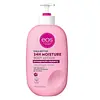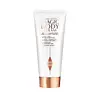What's inside
What's inside
 Key Ingredients
Key Ingredients

 Benefits
Benefits

 Concerns
Concerns

 Ingredients Side-by-side
Ingredients Side-by-side

Water
Skin ConditioningGlycerin
HumectantCaprylic/Capric Triglyceride
MaskingCetyl Alcohol
EmollientIsopropyl Palmitate
EmollientDicaprylyl Carbonate
EmollientGlyceryl Stearate Se
EmulsifyingDimethicone
EmollientParfum
MaskingButyrospermum Parkii Butter
Skin ConditioningButyrospermum Parkii Oil
EmollientHelianthus Annuus Seed Oil
EmollientPunica Granatum Extract
AstringentRubus Idaeus Leaf Extract
Skin ConditioningPetrolatum
EmollientParaffinum Liquidum
EmollientCarbomer
Emulsion StabilisingCaprylyl Glycol
EmollientHexylene Glycol
EmulsifyingPhenoxyethanol
PreservativeStearic Acid
CleansingDimethiconol
EmollientDisodium EDTA
Sodium Hydroxide
BufferingTocopheryl Acetate
AntioxidantCitric Acid
BufferingHexyl Cinnamal
PerfumingLinalool
PerfumingButylphenyl Methylpropional
PerfumingLimonene
PerfumingCitronellol
PerfumingHydroxycitronellal
PerfumingAlpha-Isomethyl Ionone
PerfumingCitral
PerfumingWater, Glycerin, Caprylic/Capric Triglyceride, Cetyl Alcohol, Isopropyl Palmitate, Dicaprylyl Carbonate, Glyceryl Stearate Se, Dimethicone, Parfum, Butyrospermum Parkii Butter, Butyrospermum Parkii Oil, Helianthus Annuus Seed Oil, Punica Granatum Extract, Rubus Idaeus Leaf Extract, Petrolatum, Paraffinum Liquidum, Carbomer, Caprylyl Glycol, Hexylene Glycol, Phenoxyethanol, Stearic Acid, Dimethiconol, Disodium EDTA, Sodium Hydroxide, Tocopheryl Acetate, Citric Acid, Hexyl Cinnamal, Linalool, Butylphenyl Methylpropional, Limonene, Citronellol, Hydroxycitronellal, Alpha-Isomethyl Ionone, Citral
Water
Skin ConditioningGlycerin
HumectantCaprylic/Capric Triglyceride
MaskingGlyceryl Stearate Se
EmulsifyingTricaprylin
MaskingCoco-Caprylate/Caprate
EmollientSoybean Glycerides
EmollientCetyl Alcohol
EmollientButyrospermum Parkii Butter Unsaponifiables
Skin Conditioning1,2-Hexanediol
Skin ConditioningPentylene Glycol
Skin ConditioningMyristyl Myristate
EmollientPotassium Cetyl Phosphate
EmulsifyingCaprylyl Glycol
EmollientCarbomer
Emulsion StabilisingAcrylates/C10-30 Alkyl Acrylate Crosspolymer
Emulsion StabilisingCamellia Oleifera Seed Oil
Skin ConditioningRosa Canina Fruit Oil
EmollientSodium Gluconate
Skin ConditioningSodium Hydroxide
BufferingCaffeine
Skin ConditioningHelianthus Annuus Seed Oil
EmollientHaematococcus Pluvialis Extract
AntioxidantMaltodextrin
AbsorbentTocopherol
AntioxidantRosa Damascena Extract
MaskingSodium Hyaluronate
HumectantAscorbyl Palmitate
AntioxidantRosa Damascena Flower Oil
MaskingRosa Damascena Flower Water
MaskingMichelia Alba Leaf Oil
MaskingAloe Barbadensis Leaf Juice
Skin ConditioningPlumeria Rubra Flower Extract
Skin ConditioningCitric Acid
BufferingPotassium Sorbate
PreservativeSodium Benzoate
MaskingLinalool
PerfumingCitronellol
PerfumingGeraniol
PerfumingWater, Glycerin, Caprylic/Capric Triglyceride, Glyceryl Stearate Se, Tricaprylin, Coco-Caprylate/Caprate, Soybean Glycerides, Cetyl Alcohol, Butyrospermum Parkii Butter Unsaponifiables, 1,2-Hexanediol, Pentylene Glycol, Myristyl Myristate, Potassium Cetyl Phosphate, Caprylyl Glycol, Carbomer, Acrylates/C10-30 Alkyl Acrylate Crosspolymer, Camellia Oleifera Seed Oil, Rosa Canina Fruit Oil, Sodium Gluconate, Sodium Hydroxide, Caffeine, Helianthus Annuus Seed Oil, Haematococcus Pluvialis Extract, Maltodextrin, Tocopherol, Rosa Damascena Extract, Sodium Hyaluronate, Ascorbyl Palmitate, Rosa Damascena Flower Oil, Rosa Damascena Flower Water, Michelia Alba Leaf Oil, Aloe Barbadensis Leaf Juice, Plumeria Rubra Flower Extract, Citric Acid, Potassium Sorbate, Sodium Benzoate, Linalool, Citronellol, Geraniol
 Reviews
Reviews

Ingredients Explained
These ingredients are found in both products.
Ingredients higher up in an ingredient list are typically present in a larger amount.
This ingredient is an emollient, solvent, and texture enhancer. It is considered a skin-softener by helping the skin prevent moisture loss.
It helps thicken a product's formula and makes it easier to spread by dissolving clumping compounds.
Caprylic Triglyceride is made by combining glycerin with coconut oil, forming a clear liquid.
While there is an assumption Caprylic Triglyceride can clog pores due to it being derived from coconut oil, there is no research supporting this.
Learn more about Caprylic/Capric TriglycerideCaprylyl Glycol is a humectant and emollient, meaning it attracts and preserves moisture.
It is a common ingredient in many products, especially those designed to hydrate skin. The primary benefits are retaining moisture, skin softening, and promoting a healthy skin barrier.
Though Caprylyl Glycol is an alcohol derived from fatty acids, it is not the kind that can dry out skin.
This ingredient is also used as a preservative to extend the life of products. It has slight antimicrobial properties.
Learn more about Caprylyl GlycolCarbomer is a polymer of acrylic acid. Its main role is to create a gel consistency.
A high amount of carbomer can cause pilling or balling up of products. Don't worry, most products contain 1% or less of carbomer.
Cetyl Alcohol is a fatty alcohol. Fatty Alcohols are most often used as an emollient or to thicken a product.
Its main roles are:
Though it has "alcohol" in the name, it is not related to denatured alcohol or ethyl alcohol.
The FDA allows products labeled "alcohol-free" to have fatty alcohols.
Learn more about Cetyl AlcoholCitric Acid is an alpha hydroxy acid (AHA) naturally found in citrus fruits like oranges, lemons, and limes.
Like other AHAs, citric acid can exfoliate skin by breaking down the bonds that hold dead skin cells together. This helps reveal smoother and brighter skin underneath.
However, this exfoliating effect only happens at high concentrations (20%) which can be hard to find in cosmetic products.
Due to this, citric acid is usually included in small amounts as a pH adjuster. This helps keep products slightly more acidic and compatible with skin's natural pH.
In skincare formulas, citric acid can:
While it can provide some skin benefits, research shows lactic acid and glycolic acid are generally more effective and less irritating exfoliants.
Most citric acid used in skincare today is made by fermenting sugars (usually from molasses). This synthetic version is identical to the natural citrus form but easier to stabilize and use in formulations.
Read more about some other popular AHA's here:
Learn more about Citric AcidCitronellol is used to add fragrance/parfum to a product. It is often derived from plants such as roses. In fact, it can be found in many essential oils including geranium, lavender, neroli, and more. The scent of Citronellol is often described as "fresh, grassy, and citrus-like".
Since the Citronellol molecule is already unstable, Citronellol becomes irritating on the skin when exposed to air.
Citronellol is a modified terpene. Terpenes are unsaturated hydrocarbons found in plants. They make up the primary part of essential oils.
Citronellol is not able to be absorbed into deeper layers of the skin. It has low permeability,
Citronellol is also a natural insect repellent.
Learn more about CitronellolGlycerin is already naturally found in your skin. It helps moisturize and protect your skin.
A study from 2016 found glycerin to be more effective as a humectant than AHAs and hyaluronic acid.
As a humectant, it helps the skin stay hydrated by pulling moisture to your skin. The low molecular weight of glycerin allows it to pull moisture into the deeper layers of your skin.
Hydrated skin improves your skin barrier; Your skin barrier helps protect against irritants and bacteria.
Glycerin has also been found to have antimicrobial and antiviral properties. Due to these properties, glycerin is often used in wound and burn treatments.
In cosmetics, glycerin is usually derived from plants such as soybean or palm. However, it can also be sourced from animals, such as tallow or animal fat.
This ingredient is organic, colorless, odorless, and non-toxic.
Glycerin is the name for this ingredient in American English. British English uses Glycerol/Glycerine.
Learn more about GlycerinGlyceryl Stearate Se is a self-emulsifying (SE) form of glyceryl stearate. Self-emusifying means this ingredient automatically blends with water. It is an emulsifier, emollient, and cleansing agent.
As an emulsifier, Glyceryl Stearate Se prevents ingredients such as oil and water from separating. It is also a surfactant, meaning it helps cleanse the skin. Surfactants help gather oil, dirt, and other pollutants so they may be rinsed away easily.
Emollients help your skin stay smooth and soft. It does so by creating a film on top of the skin that helps trap moisture in.
Learn more about Glyceryl Stearate SeHelianthus Annuus Seed Oil is the oil derived from the seeds of a Sunflower. Sunflower seed oil is non-fragrant. It is an emollient, meaning it helps to soften the skin.
Sunflower seed oil contains many fatty acids. The fatty acids found in sunflower seeds include (from highest amount to least): linoleic acid, myristic acid, palmitic acid, stearic acid, arachidic acid, oleic acid, and linolenic acid.
These fatty acids help the skin create ceramides. Ceramides play a role in repairing the skin barrier.
Helianthus Annuus Seed Oil helps moisturize the skin. This in turn helps the skin look more rejuvenated and smoother.
Sunflowers are rich in vitamin E.
Historians believe Indigenous cultures of North America domesticated sunflowers before corn. Thus they relied on sunflower oil for a variety of uses. One such use is moisturizing skin and hair.
Sunflower seed oil may not be fungal acne safe. We recommend speaking with a professional if you have any concerns.
Learn more about Helianthus Annuus Seed OilLinalool is a fragrance and helps add scent to products. It's derived from common plants such as cinnamon, mint, citrus, and lavender.
Like Limonene, this ingredient oxidizes when exposed to air. Oxidized linalool can cause allergies and skin sensitivity.
This ingredient has a scent that is floral, spicy tropical, and citrus-like.
Learn more about LinaloolSodium Hydroxide is also known as lye or caustic soda. It is used to adjust the pH of products; many ingredients require a specific pH to be effective.
In small amounts, sodium hydroxide is considered safe to use. However, large amounts may cause chemical burns due to its high alkaline.
Your skin has a natural pH and acid mantle. This acid mantle helps prevent harmful bacteria from breaking through. The acid mantle also helps keep your skin hydrated.
"Alkaline" refers to a high pH level. A low pH level would be considered acidic.
Learn more about Sodium HydroxideWater. It's the most common cosmetic ingredient of all. You'll usually see it at the top of ingredient lists, meaning that it makes up the largest part of the product.
So why is it so popular? Water most often acts as a solvent - this means that it helps dissolve other ingredients into the formulation.
You'll also recognize water as that liquid we all need to stay alive. If you see this, drink a glass of water. Stay hydrated!
Learn more about Water